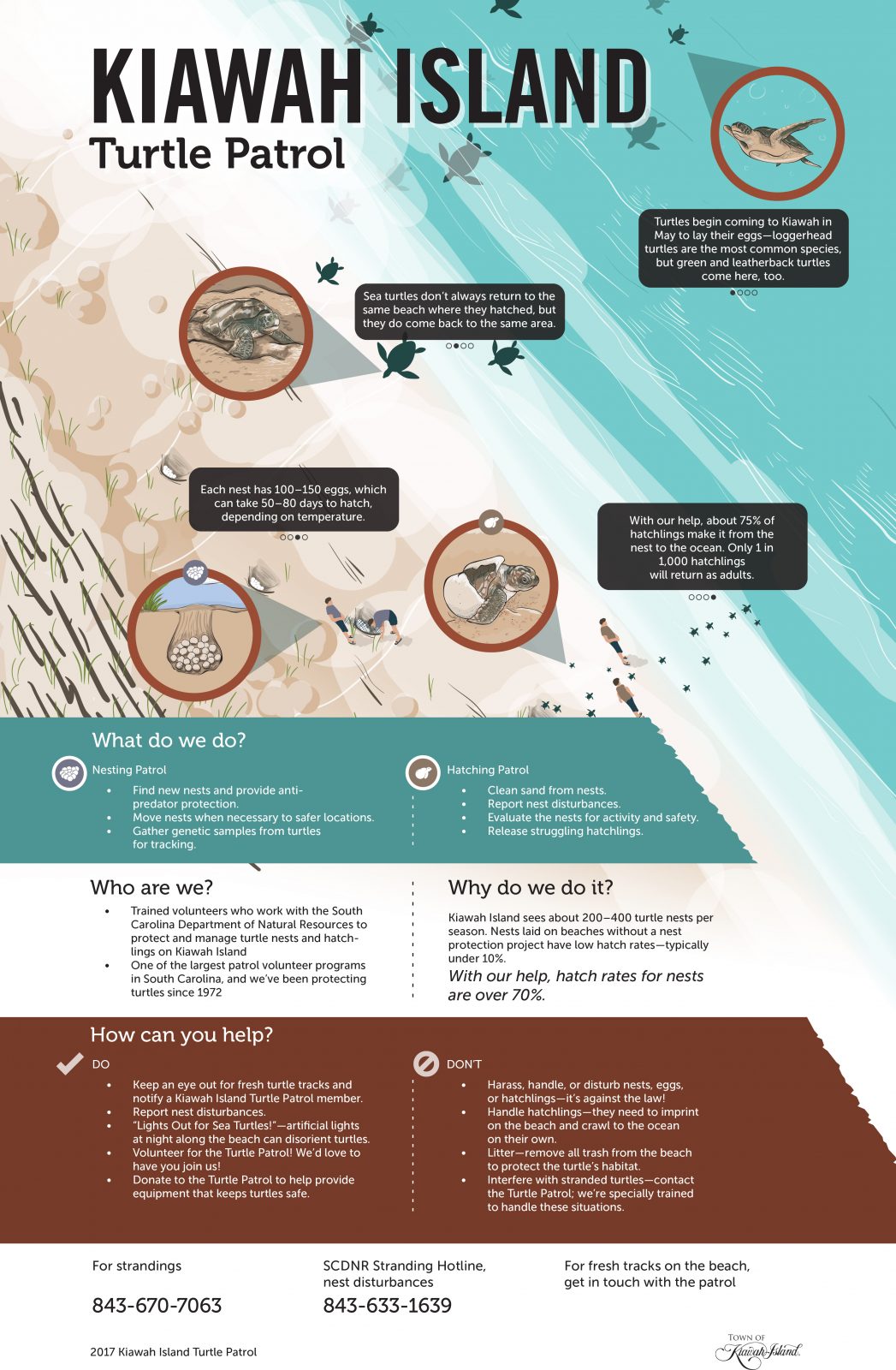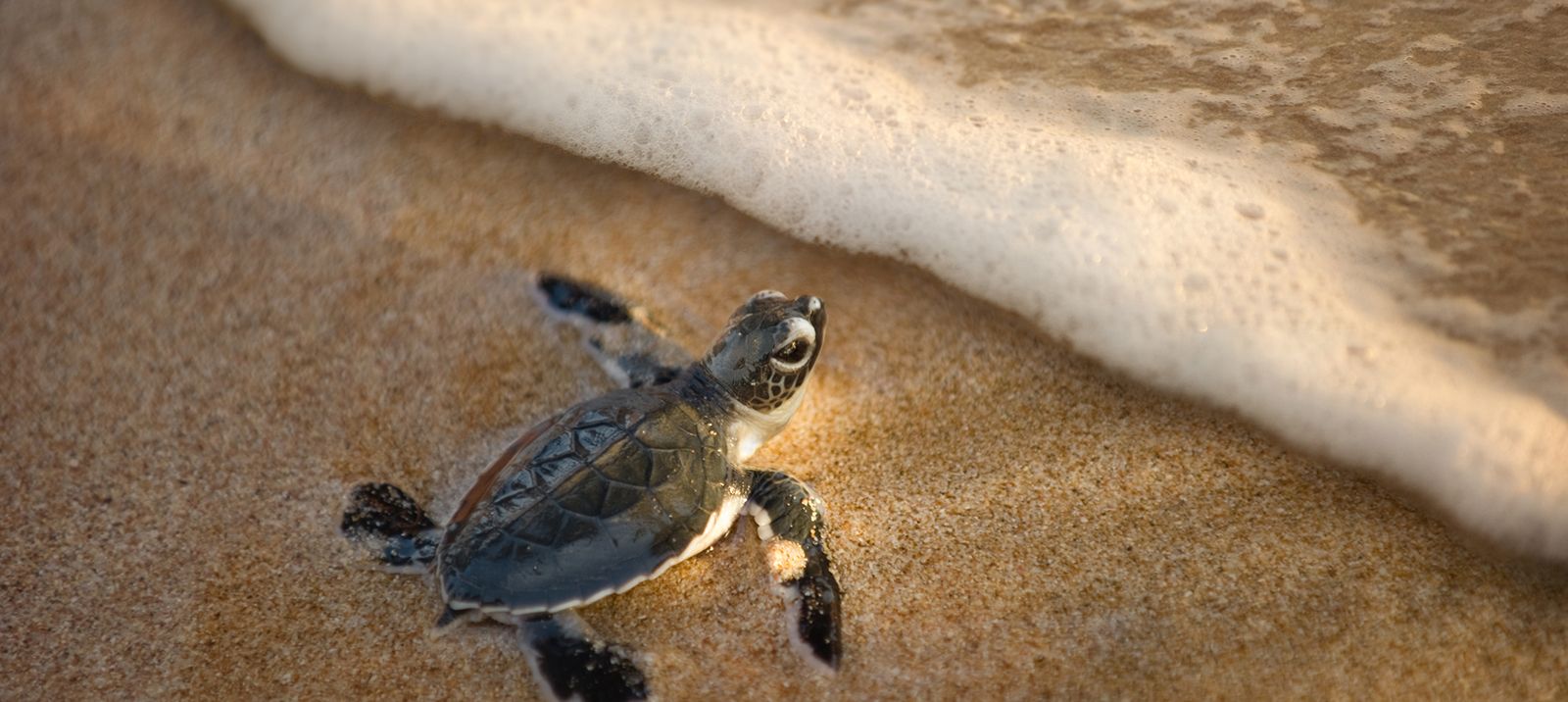Meet Kiawah Island’s Loggerhead Sea Turtles
Lowcountry Wildlife: Kiawah Island Turtles
With over 10,000 acres of land and 10 miles of beach, Kiawah Island serves as a vital nesting ground for Loggerhead turtles. Each spring, a large number of sea turtles emerge from the waters of the Atlantic in search of a nesting place to lay their eggs. This precarious time is filled with dangers that put both adults and their unborn hatchlings at great risk. Fortunately, the Kiawah community has a long-standing tradition in place to protect the mothers and their young from harm, and ultimately, their rate of survival.
Discover the surprising behaviors that bring many of these sea turtles to Kiawah’s shores, and how the community does its part in protecting the next generation to ensure their survival.
How to Spot a Loggerhead Turtle
Scientists are only aware of seven sea turtle species in existence. The Loggerhead is the largest of all seven, often weighing upwards of 300 pounds. Females tend to be larger in size than males. Males are easily identifiable by their long, tapered tail that extends beyond the base of the shell. In both genders, the shells resemble the shape of a heart — a tell-tale sign of a Loggerhead. With a large head and a powerful set of jaws, these docile animals can crush a variety of crabs, fish, and mollusks in just one bite.
Loggerheads also possess large, giraffe-like spots that cover the tops of their head and flippers. Each curved flipper serves a purpose in propelling the turtle through even the roughest of waters. And although they are slow swimmers, their stamina is unmatched as they’ve been documented to swim as far as 3,000 miles.
When exploring Kiawah’s waters, keep an eye out for one of these beauties near the water’s surface. Sea turtles require oxygen to breathe and will often be spotted peeking out from the water’s surface. If you are lucky enough to see one, please be sure to leave it be!
Where to Find Kiawah Island Turtles
Loggerheads spend most of their time in coastal waters and rarely come onto shore. However, during nesting season you may encounter females on the beach, especially in the evenings. They have come to shore in search of a safe place to lay their eggs.
From late spring to early summer, you will often see tracks left behind in the sand. As the turtle moves along, its heavy shell and large flippers leave behind distinct markings that are unique to their species.
If you do stumble across a Loggerhead turtle, respect her space! Otherwise, she may retreat back to sea from distress and put herself and her eggs in harm’s way.
The Nesting and Hatching Process
Sea turtles are known for their remarkable nesting behaviors, which is what separates them from most other types of marine wildlife.
Amazingly, female Loggerheads often return to the same area they hatched from years ago. Hatchlings go through a process called imprinting, a natural process in which they are able to memorize the location’s geomagnetic field. They then go on to make the journey from their nest back to sea. Years later, the matured females return to continue the cycle.
Once the adult Loggerhead finds her way back to where she was hatched, she makes her way onto the beach, albeit slowly, to find an ideal nesting site. Using her flippers, she will dig a deep enough hole to serve as an incubator. Females can lay up to five clutches of eggs, a total of around 130 eggs. After she has laid her eggs, she covers the nest with sand and makes her way back into the ocean.
The eggs incubate for roughly 40 to 75 days before hatching. Interestingly, the temperature of the sand can affect the gender of the hatchling. Cool temperatures tend to form male sea turtles, while warmer temperatures create females. Once the hatchlings have come out of their shells, they make the trek back to sea, using the moon’s reflection in the water as their guide.
Kiawah’s Turtle Patrol
Survival rates for turtle hatchlings are extremely low due to the many predators. With a hand from the local community, these special turtles get a better chance at life thanks to Kiawah’s Turtle Patrol program.
Nesting efforts have been in existence since 1973. The Town of Kiawah Island has provided funding and logistical support to the program since 1990. Patrol efforts do an excellent job of keeping Loggerhead predators at bay such as raccoons, foxes, seagulls, lizards, crabs, and other land mammals.
During the nesting season, volunteers patrol the entire beach by truck each morning. Their goal is to locate nests that have been laid the previous night and mark them with a numbered post. Nests that are located too low on the beach are moved landward to protect them from being washed over by high tides.

When nests begin to hatch, numerous groups of volunteers patrol sections of the beach daily to check for an emergence of hatchlings. At some point after hatching, each nest is excavated and an inventory is taken of the nest contents. From this data, they are able to get an idea of how many eggs have been laid on Kiawah’s soil.
How You Can Help Protect Kiawah Island’s Turtles
Every Kiawah resident and visitor can do their part in helping this integral Island species. Beach property homeowners are asked to turn off all outdoor lighting once it gets dark out. Sea turtles are attracted to artificial light, so it can be disorienting and lead them astray.
When spending time at the beach, pay attention to signs of unmarked nests and notify a Kiawah Island Turtle Patrol member as soon as possible. Leave the nest be — and encourage others to do the same. Never touch the eggs or hatchlings, as human interaction may interfere with their development and chances of survival.
Meet Kiawah Island’s Wildlife
Every so often, the odd Leatherback or Green sea turtle will also make an appearance on Kiawah. As a keystone species, Kiawah Island’s turtles are crucial for the survival of other land and marine animals on the Island. Aquatic and land mammals, freshwater fish, exotic birds and the like, are all a part of Kiawah’s intricate ecosystem.
The community’s mission is to preserve the Island’s natural beauty and all of the creatures that call it home. Explore our Wildlife Lookbook to discover the abundance of wildlife that calls this place home. Download this resource via the button below for an up-close look at Kiawah Island’s turtles and other wildlife.

This content was originally posted in 2019 and refreshed in 2021.






